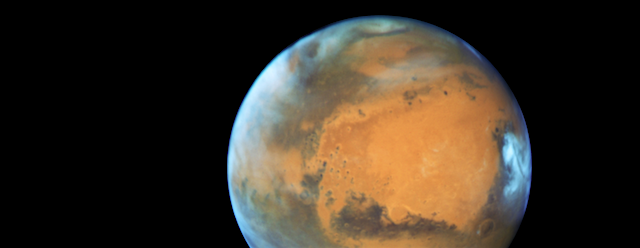 The planet Mars has fascinated scientists for over a century. Today, it is a frigid desert world with a carbon dioxide atmosphere 100 times thinner than Earth’s. But evidence suggests that in the early history of our solar system, Mars had an ocean’s worth of water. NASA’s James Webb Space Telescope will study Mars to learn more about the planet’s transition from wet to dry, and what that means about its past and present habitability.
The planet Mars has fascinated scientists for over a century. Today, it is a frigid desert world with a carbon dioxide atmosphere 100 times thinner than Earth’s. But evidence suggests that in the early history of our solar system, Mars had an ocean’s worth of water. NASA’s James Webb Space Telescope will study Mars to learn more about the planet’s transition from wet to dry, and what that means about its past and present habitability.
Mars will be targeted as part of a Guaranteed Time Observation (GTO) project led by Heidi Hammel, a planetary astronomer and executive vice president of the Association of Universities for Research in Astronomy (AURA) in Washington, D.C. The GTO program provides dedicated time to the scientists who have worked with NASA to craft the science capabilities of Webb throughout its development. Hammel was selected by NASA as a JWST Interdisciplinary Scientist in 2003. Mars will be visible to Webb from May to September 2020 during its first year of operations, known as Cycle 1.
“Webb will return extremely interesting measurements of chemistry in the Martian atmosphere,” noted Hammel. “And most importantly, these Mars data will be immediately available to the planetary community to enable them to plan even more detailed Mars observations with Webb in future cycles.”
“We are all looking forward to Webb’s observations of Mars. I just know they will be fantastic, with the potential for immediate scientific discoveries,” said Jim Green, director of NASA’s Planetary Science Division, NASA Headquarters, Washington, D.C. (…)
One key asset is Webb’s ability to take a snapshot of the entire disk of Mars at once. Orbiters, in contrast, take time to make a full map and therefore can be affected by day-to-day variability, while rovers can only measure one location. Webb also benefits from excellent spectral resolution (the ability to measure small differences in wavelengths of light) and a lack of interfering atmosphere that plagues ground-based measurements from Earth.
That said, observing Mars with Webb will not be easy. “Webb is designed to be able to detect extremely faint and distant targets, but Mars is bright and close,” explained Geronimo Villanueva of NASA’s Goddard Space Flight Center, Mars lead on the GTO project. As a result, the observations will be carefully designed to avoid swamping Webb’s delicate instruments with light.
“Very importantly, observations of Mars will also test Webb’s capabilities in tracking moving objects across the sky, which is of key importance when investigating our solar system,” said Stefanie Milam at NASA’s Goddard Space Flight Center, Greenbelt, Md. who is coordinating the solar system program with Webb. [More at link]








